Treasures of Americana
This rare copy of the United States Constitution and other Americana from Vassar’s Department of Archives & Special Collections were on public view briefly this spring in an exhibit organized to celebrate the official opening of the Martha and Bronson Ingram Library Addition to Thompson Library. Treasures of Americana, 1760–1830, featured a variety of interesting works, some of them shown below.
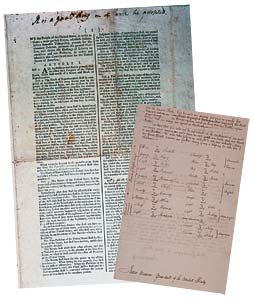
1. This rare copy of the U. S. Constitution was printed in 1787 before the official edition.
2. The second document is a petition from the Seneca Nation to President James Monroe in 1818.
Twenty-two Seneca chiefs signed against their names with an X.
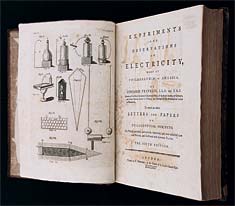
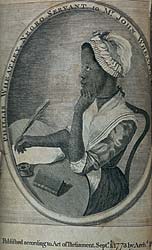
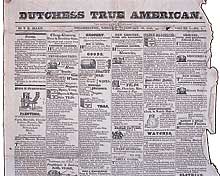
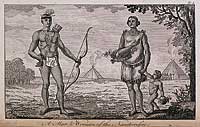
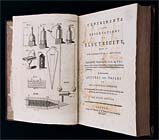
Remaining photos above:
3. Title page of The History of Printing in America by Isaiah Thomas, 1810.
4. Frontispiece of Phillis Wheatley's 1773 Poems on Various Subjects, Religious and Moral.
5. Front page of Dutchess True American, January 30, 1828.
6. Illustration from Travels through the Interior Parts of North-America, in the Years 1766, 1767, and 1768, Jonathan Carver, 1778.
7. Benjamin Franklin's Experiments and Observations on Electricity, 1774.
Annotations for Documents featured in Treasures of Americana, 1760–1830.
1. United States. We, the People of the United States, in Order to Form a More Perfect Union, Establish Justice, Insure Domestic Tranquility, Provide for the Common Defence, Promote the General Welfare, and Secure the Blessings of Liberty to Ourselves and our Posterity, Do Ordain and Establish this Constitution for the United States of America. [Philadelphia: Printed by Dunlap and Claypoole,1787].
Convention delegates asked Gouverneur Morris of Pennsylvania to put together a final draft of the Constitution, and he completed the task in September 1787. The rare document exhibited here was printed before the official edition, and represents the first issue of the Constitution as agreed. It includes the resolution, a letter from George Washington transmitting the Constitution to Congress, and a resolution that the report, with the resolution, and letter be transmitted to the state legislatures.
2. Seneca Nation. Petition to President James Monroe, January 1, 1818. Jasper Parrish Papers, Lucy Maynard Salmon Collection of Historical Materials.
This scribe’s copy of a petition to James Monroe (1758-1831) mentions the concern of the Indians of the Six Nations over Seneca money controlled by the United States president, as well as other matters. Twenty-two chiefs of the various villages signed the petition, which is a fragment of a longer document.
3. Thomas, Isaiah. The History of Printing in America with a Biography of Printers, and an Account of Newspapers: to which is Prefixed a Concise View of the Discovery and Progress of the Art in Other Parts of the World: in Two Volumes. Worcester: From the Press of Isaiah Thomas, Jun., Isaac Sturtevant, Printer, 1810.
After settling in Worcester, Massachusetts, Isaiah Thomas became the leading publisher in the United States. His press was known for both the beauty of its typography as well as the importance of its titles. Thomas (1749-1831) wrote his History after his fortune had been made; to this day it serves as authority in the field of early American printing.
4. Wheatley, Phillis. Poems on Various Subjects, Religious and Moral. London: Printed for A. Bell…, 1773.
Eighteenth-century readers of Phillis Wheatley’s (c. 1753–1784) Poems were impressed not only by the quality of the verse, but also by the fact that the author was an African-American slave living in Boston. The book includes a copy of a letter sent by John Wheatley—Phillis’s master—to the publisher, testifying to her talents, as well as a copy of a public notice signed by John Hancock, Charles Chauncy, and others confirming that Phillis Wheatley was indeed the author of the poems.
5. Dutchess True American, January 30, 1828. The Dutchess True American was a short-lived newspaper founded early in 1828 by Peter K. Allen. In addition to carrying news and notices, it supported Andrew Jackson as a political candidate. Copies of the paper are rare, since after a year of publication it was discontinued and moved to Ulster County.
6. Carver, Jonathan. Travels through the Interior Parts of North-America, in the Years 1766, 1767, and 1768. London: Printed for the author; and sold by J. Walter [etc.], 1778. Jonathan Carver (1710-1780) grew up in New England and by 1760 served as a captain in a Massachusetts regiment. His travels took him through the Great Lakes, to the Mississippi River, and into Minnesota before returning to Boston. This first edition of the travels was extremely popular at the time, and the work was re-published in a variety of locations in subsequent years. Much of Travels deals with Native Americans, and because there are no citations, some have questioned whether Carver was the true author.
7. Franklin, Benjamin. Experiments and Observations on Electricity, Made in Philadelphia in America ... to Which Are Added, Letters and Papers on Philosophical Subjects. London: Printed for F. Newbery, at the corner of St. Paul’s Church-yard, 1774.
In early life Benjamin Franklin (1706–1790) distinguished himself in Philadelphia as publisher of the Pennsylvania Gazette and Poor Richard’s Almanack. Financial success in these ventures gave him the means to study electricity. Between 1751 and 1754 he published three pamphlets discussing his experiments; they appeared together in one volume in 1769 and again in 1774. In these works Franklin identified lightning with electricity, described the use of lightning rods, and made other important contributions to the theory of electricity.
A printed catalog of the exhibit can be ordered by contacting the Department of Archives & Special Collections.
